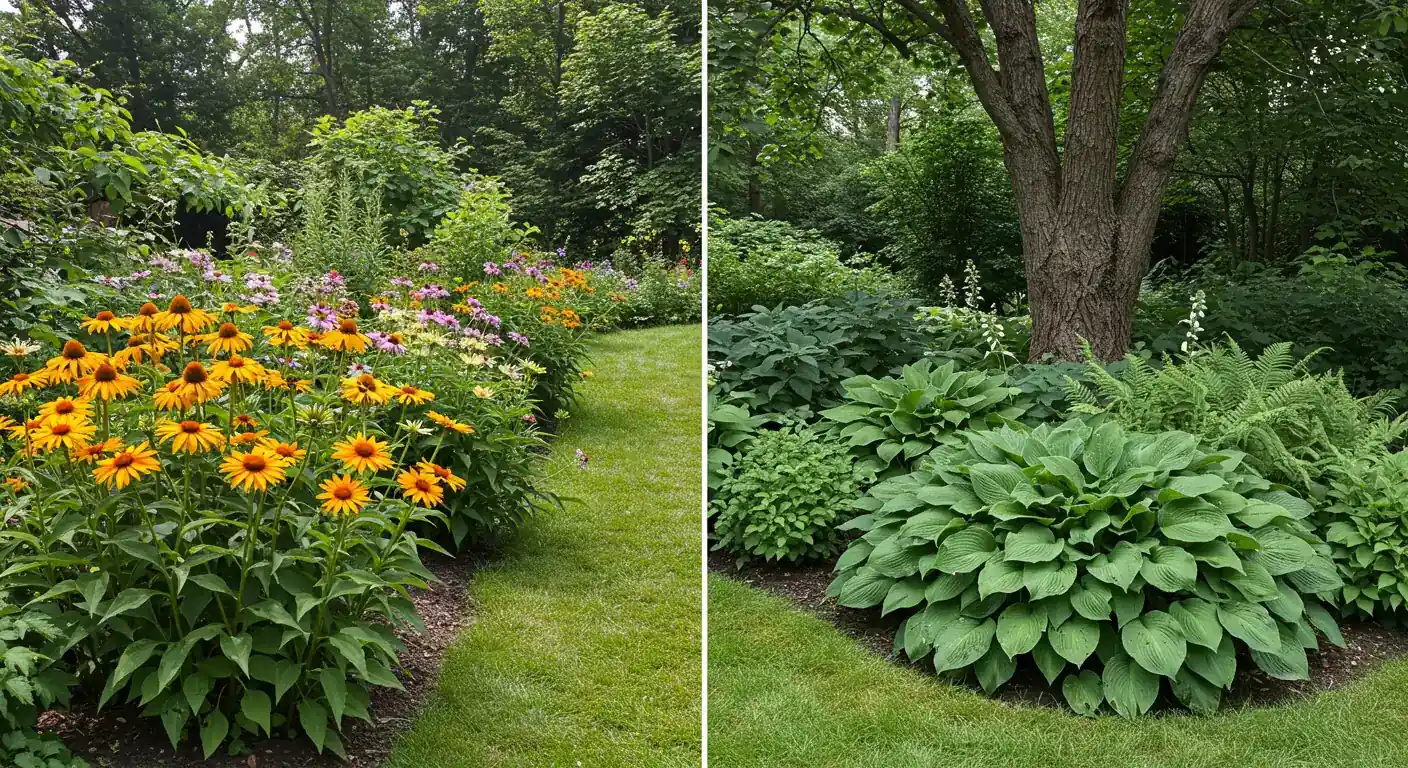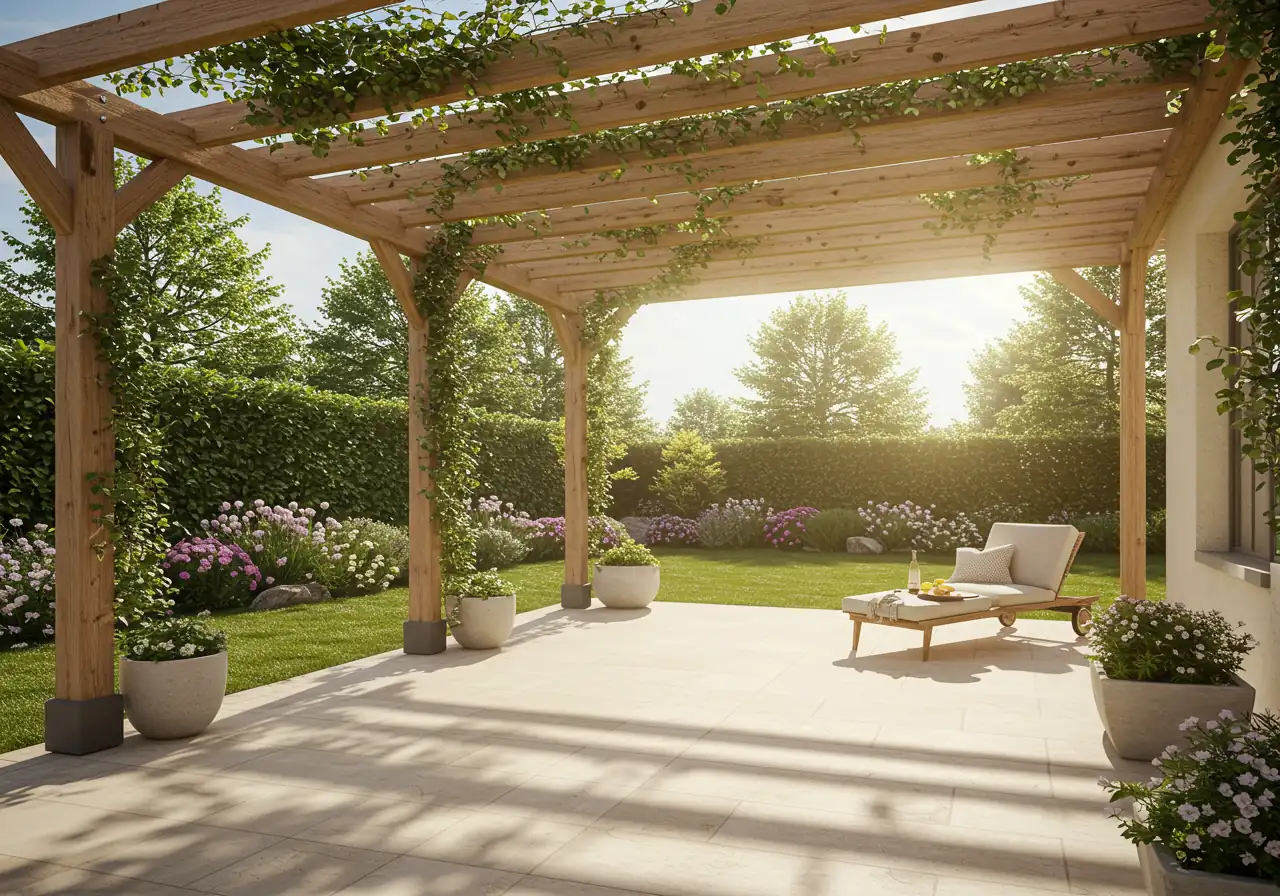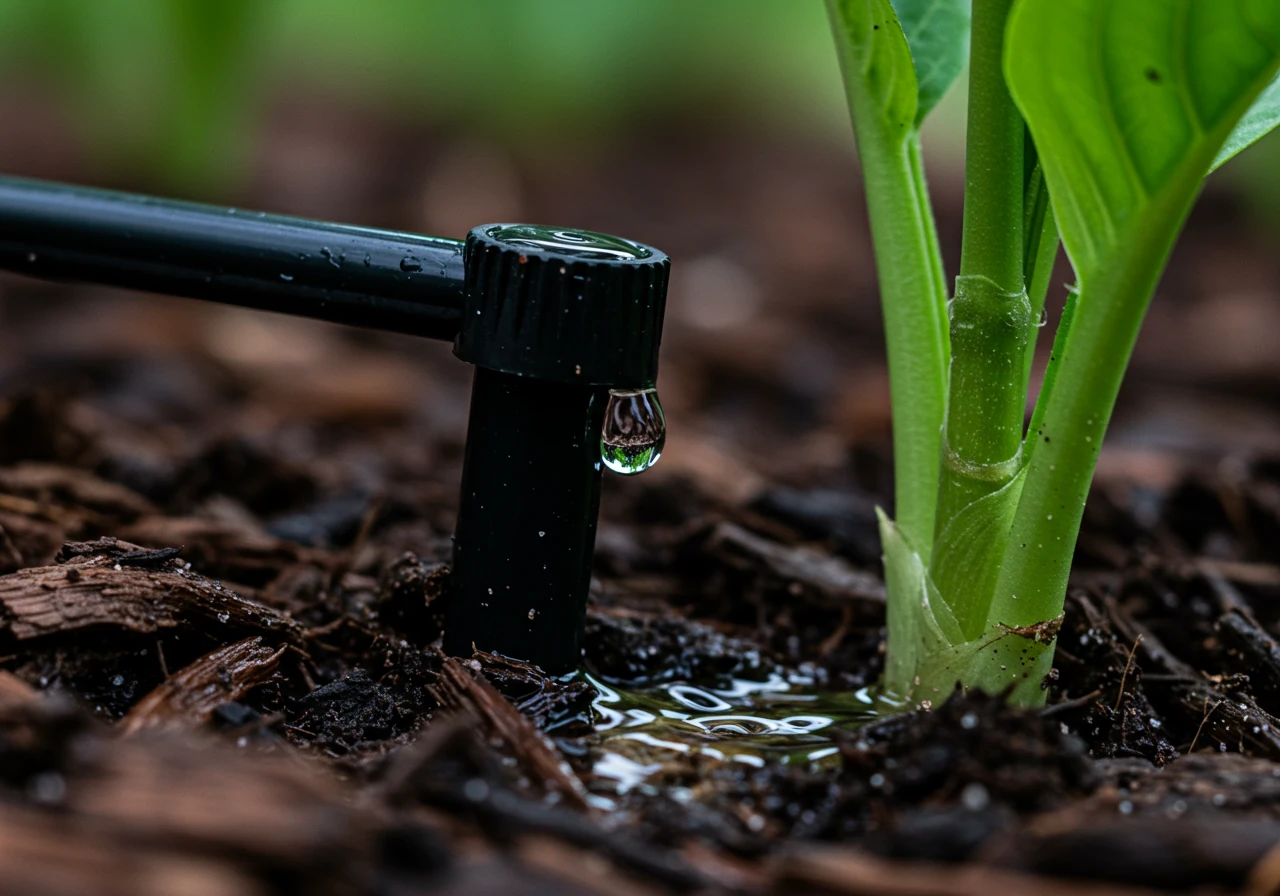Hot Spots? Shade? Winchester Summer Microclimate Fixes
Struggling with uneven garden conditions? Request a personalized quote today to tackle your Winchester yard's microclimates!
Quick Takeaways:
- Understand microclimates (sun, shade, wind, moisture differences).
- Cool hot spots with shade (trees, structures) and mulch.
- Brighten shade spots with right plants and light-reflecting elements.
- Water efficiently using drip irrigation/soaker hoses based on zone needs.
- Choose Ottawa-hardy plants suited for specific sun/shade conditions.
Introduction: Why Your Winchester Yard Feels Like Two Different Seasons at Once

Hey Winchester neighbours! Ever wander through your yard and feel like you've crossed a time zone, or at least a seasonal border? You know the feeling – the tomatoes basking against the sunny south-facing wall are thriving like they're on a tropical vacation, while the hostas huddled under that big maple tree seem perpetually stuck in chilly early spring, metaphorically speaking, of course. It’s almost like one part of your landscaping is enjoying peak summer while another patch hasn't quite gotten the memo!
You're not going crazy; you're just experiencing yard microclimates. It's a super common phenomenon in the diverse landscapes around the Ottawa region, whether you're gardening in nearby Greely or right here in Winchester. These are essentially small zones within your own property that have noticeably different environmental conditions – think variations in sun exposure, wind patterns, soil moisture, and even temperature, compared to the yard as a whole or the general local climate. Understanding these mini-environments is the secret weapon for smarter gardening and landscaping choices. Let’s dive into why your yard might have these split personalities and how you can work with these unique variations, not against them, for a happier, healthier outdoor space. Considering a major overhaul? See some inspiring landscape transformations we've completed.
Decoding Your Yard's Personality: Understanding Microclimates in the Ottawa Region
Okay, let's dive deeper into what makes your Ottawa yard tick! Think of your property less like a single, uniform space and more like a patchwork quilt – different squares, different conditions. These mini-zones, or microclimates, are shaped by a few key players, and understanding them is like getting a secret decoder ring for your gardening success.
First up is the big one: sun exposure. Big surprise, right? But it's more than just sunny or shady. A south-facing wall in Barrhaven gets absolutely baked by the sun all day long, creating a pocket desert, while the north side under your neighbour's towering maple might feel like perpetual twilight, even in July. Tall trees or buildings cast significant shade, dramatically affecting temperature and dictating which plants will thrive versus which will sulk. This difference is crucial knowledge for creating stunning Nepean shade garden designs and vital when learning how to handle tricky Nepean garden microclimate hot and shade spots.
Then there's wind. Is one corner of your yard always getting blasted by those Ottawa breezes, drying out soil moisture and whipping delicate plants around? Or do you have nicely sheltered nooks perfect for less hardy flowers? Fences, hedges, your house, or even neighbouring properties can create unexpected wind tunnels or wonderfully calm pockets.
Water movement and soil moisture also play a huge role. Does water pool in a low spot every time it rains, suggesting poor drainage? Or does it run right off a slope, leaving the area perpetually thirsty? This is often tied directly to your soil type. Areas around Ottawa can vary wildly – think of the heavy clay common in parts of Greely that holds water like a sponge (sometimes too well!), versus the sandier loam you might find closer to the Rideau River in places like Kars, which drains much faster. Need help getting your soil right? Check out our soil preparation services.
Don't forget about structures and surfaces! Your brick house wall, that dark asphalt driveway, or even a light-coloured stone patio absorb heat during the day and radiate it back out, especially in the evening. These hardscape elements create surprisingly warm zones nearby – perfect for heat-loving herbs or tomatoes, but potentially stressful for cool-weather plants. Knowing how to manage these areas is key, like tackling Russell garden hot spots with microclimate tips.
So, how do you become a microclimate detective in your own yard? It’s easier than you think:
- Observe Like a Hawk: Spend time walking your yard at different times of the day (morning, noon, late afternoon) and pay attention through the seasons. Where does the sun hit longest and hardest? Where does snow melt first in spring or linger longest? Where do puddles form after rain?
- Feel the Difference: Simply walk around. Can you feel a temperature drop when you step into the shade? Is it noticeably warmer next to the south-facing house foundation?
- Check the Soil: Dig a small hole in various spots after a decent rain (or watering). Is the soil soggy, nicely moist, or surprisingly dry? Note the texture – sticky clay, gritty sand, or rich loam?
Getting to know your yard's unique personality zones helps you choose plants that will truly thrive, not just survive. It’s the secret ingredient for smarter landscaping and more rewarding gardening. If decoding these zones feels overwhelming or you want help tailoring your yard perfectly, exploring professional landscaping and garden care services can be a great next step. Ultimately, understanding these subtle variations means you can find practical Vernon microclimate garden tips to solve common issues and unlock the full potential of your Ottawa outdoor space. Thinking about who we are and our approach? Learn more about Clean Yards!
Taming the Toasty Zones: Cooling Down Those Sun-Baked Hot Spots

Alright, so you’ve identified those spots in your Ottawa yard that feel more like the surface of the sun than Eastern Ontario? Those south-facing walls or wide-open areas blasted by sun exposure all day? Don't sweat it (well, maybe sweat less after reading this)! There are plenty of clever landscaping tricks to turn down the heat and make these areas more comfortable for both you and your plants.
Plant Some Shade (Nature's Air Conditioner):
The absolute champion of cooling things down is a strategically placed tree. Planting deciduous trees (the ones that lose their leaves) to the south or west of a hot zone provides glorious shade in summer but lets the warming sun through in winter – pretty smart, eh? For our Ottawa climate (generally Zone 5a/b), consider hardy native plants like Red Oak or Sugar Maple if you have the space, like on larger lots you might find out in Manotick. For smaller yards, maybe in parts of Richmond, consider more compact options like Serviceberry or ornamental maples. Planting the right tree is a fantastic long-term investment. If you're considering significant planting or garden redesigns, exploring professional landscaping and garden services can help ensure you choose the perfect specimens for your space.
Build It Cool:
Don't want to wait years for a tree to mature? Structures can offer more immediate relief. Think pergolas draped with fast-growing (but non-invasive!) vines, arbors creating shady entryways, or even simple shade sails strategically angled. These add architectural interest and dial down the intensity of the sun.
Watch Your Step (Hardscaping Matters):
Believe it or not, your patio or walkway material makes a huge difference! Dark asphalt or concrete absorbs and radiates a lot of heat. Lighter-coloured pavers, flagstone set in sand or gravel, or even decking tend to stay cooler. Permeable options (materials that let water seep through) are even better, as they allow for some evaporative cooling and better soil moisture management underneath. Avoid vast expanses of dark, non-porous surfaces right next to the house if heat is a concern.
Cover the Ground (Literally):
Bare soil heats up fast and reflects warmth back up. Covering it is key!
- Groundcovers: Planting dense, low-growing groundcovers acts like a living mulch, shading the soil, reducing erosion, and keeping things cooler. Creeping thyme or sedum varieties often love sunny spots.
- Mulch Magic: Applying a few inches of organic mulch (like shredded bark or wood chips) is one of the easiest and most effective strategies. It insulates the soil, drastically reduces evaporation (meaning less watering!), suppresses weeds, and keeps plant roots cooler. It’s an eco-friendly win! Keeping your beds tidy with good mulch coverage is essential, something expertly handled with professional mulching and edging services.
- Healthy Lawn: Even grass plays a role! A dense, healthy lawn is significantly cooler than bare soil or pavement. Keeping up with proper expert lawn care techniques contributes to a cooler overall yard.
Add a Splash (Optional Cooling):
A small fountain, bubbler, or even a bird bath adds moisture to the air through evaporation, creating a minor cooling effect in the immediate vicinity. Plus, the sound of water is inherently relaxing!
Tackling a hot spot might involve combining a few of these ideas. Maybe start with improving the ground layer with mulch and groundcover, then plan for a small tree or pergola. Need help clearing out a baked, weedy patch to start fresh? Whether it's a full overhaul or just prepping the space, like our expert garden clean-up in Kars, professionals can give you a head start. We value your trust when you reach out; you can review our website privacy policy anytime to see how we handle your information.
Let There Be (Some) Light: Making the Most of Shady Spots

Okay, let's venture into the mysterious, sometimes gloomy, but often surprisingly beautiful world of your yard's shady corners! That spot under the big maple or along the north side of the house doesn't have to be a sad, bare patch where lawnmowers fear to tread. With a little know-how, you can transform these low-light areas into lush, inviting retreats. Think of it less as a problem zone and more as an opportunity for some seriously cool landscaping.
Finding Friends for the Shadows: Choosing the Right Plants
The number one rule for shade gardening? Don't try to force sun-loving plants into the dark! It’s like asking a beach bum to enjoy a polar plunge – they might survive, but they won't be happy. Instead, embrace plants that naturally thrive in lower light conditions. Luckily, Ottawa's climate offers plenty of gorgeous options:
- Foliage All-Stars: Hostas (in endless varieties!), Ferns (like Ostrich or Maidenhair), Brunnera (Jack Frost is stunning), and Heuchera (Coral Bells, with amazing leaf colours) are your best friends. They offer texture and colour without needing loads of blooms.
- Flowering Beauties: Astilbe (feathery plumes), Bleeding Hearts (classic charm), Lungwort (Pulmonaria - pretty leaves and flowers), and some varieties of Hydrangea (especially Oakleaf or Annabelle) can provide lovely flowers in partial shade.
- Groundcovers: Pachysandra, Vinca Minor (Periwinkle), or Ajuga (Bugleweed) can create a living carpet where grass struggles.
Remember, "shade" isn't uniform. You've got full shade (less than 3 hours of direct sun), partial shade (3-6 hours), and dappled shade (filtered light, like under a high-branched tree). Observe your spot and choose plants accordingly!
A Little Light Pruning Goes a Long Way
Sometimes, the shade is created by your own trees. While you don't want to butcher them, selective pruning can make a difference. Removing a few lower branches or carefully thinning the canopy allows more dappled sunlight to reach the ground, opening up possibilities for a wider range of plants. This isn't about drastically changing the tree, just letting a little more light filter through. If you're unsure, professional tree care advice is always best. Our team can provide expert garden maintenance, including appropriate pruning.
Bright Ideas: Using Light-Reflecting Elements
Boost the brightness visually! Use light-coloured gravel for pathways, incorporate pale stepping stones, or even add a strategically placed piece of garden art in a lighter colour. These elements can subtly bounce around the available light, making the area feel less dim. Avoid dark mulch if you want maximum brightness; lighter shredded cedar can work, but balance this with the moisture retention benefits of darker mulches.
Designing for Drama (Without the Sun)
In shady spots, focus on contrasting textures and foliage shapes. Pair the bold leaves of a Hosta with the delicate fronds of a Fern. Mix deep greens with chartreuse or variegated leaves. This creates visual interest that doesn't depend solely on flowers. Think layers – taller shrubs in the back, medium perennials in the middle, and groundcover in the front. Tackling an overgrown, shady mess to implement a new design might feel daunting, but getting help like a thorough Marionville yard cleanup service can give you a fresh slate.
Dealing with Dampness: Improving Drainage
Shady areas often stay damp longer, especially with the heavy clay soil common in areas around Ottawa, like Metcalfe or Osgoode. Poor drainage plus shade can be a recipe for soggy roots and unhappy plants. The solution? Improve your soil! Amending the soil with generous amounts of compost or other organic matter is crucial. This helps break up compacted clay, improving airflow and allowing excess soil moisture to drain away. Proper expert soil preparation techniques are absolutely key before planting anything in a challenging shady spot. If the area is particularly soggy, you might even consider creating slightly raised beds.
Starting a shade garden project often involves clearing out what's not working – maybe struggling grass or persistent weeds. For homeowners in Metcalfe needing a hand getting started, our reliable Metcalf property cleanup service can handle the initial clearing and prep work. While shady areas aren't ideal for traditional lawns, some fine fescue mixes tolerate shade better than Kentucky Bluegrass; however, achieving lush turf without adequate sun is very difficult, unlike areas suitable for professional sod installation services. We respect your privacy when you inquire about any of our services; feel free to review our company privacy policy details.
So, embrace the shade! With the right plants and a few clever tricks, you can create a cool, green oasis in those less sunny parts of your yard.
Comparing Shade Plant Options
Hostas (Plantain Lilies)
Incredibly versatile foliage plants known for their wide range of leaf sizes, shapes, and colours (blue, green, gold, variegated). They thrive in partial to full shade with consistent moisture. Relatively low maintenance, but watch out for slugs and deer! Great for adding bold texture.
Ferns
Offer delicate, feathery texture that contrasts beautifully with bolder plants like Hostas. Varieties like Ostrich Fern, Maidenhair Fern, and Japanese Painted Fern do well in shady, moist conditions. They add an elegant, woodland feel. Ensure good drainage for most types.
Heuchera (Coral Bells)
Prized for their stunning foliage colours ranging from lime green to deep purple, bronze, and silver. They produce delicate flower spikes but are primarily grown for leaves. Prefer partial shade and well-drained soil. Can add vibrant colour accents to shade gardens.
Water Wisdom: Irrigating Your Diverse Landscape Efficiently

Alright, let's talk about watering! Keeping your plants happy across those different microclimates in your Barrhaven yard without wasting water (or drowning something!) can feel like conducting an orchestra. That sun-baked patch near the driveway needs a different tune than the shady ferns under the maple. Fear not, efficient irrigation isn't rocket science, just smart gardening!
Water Where It Counts: Drip & Soak
Forget waving a sprinkler around like you're trying to put out a five-alarm fire, hoping some water lands where it's needed. For maximum efficiency, especially in diverse landscaping, targeted watering is key.
- Drip Irrigation: Think tiny hoses with little emitters delivering water directly to the base of each plant. Perfect for veggie gardens, flower beds, and those thirsty hot spots. Minimal evaporation, maximum impact!
- Soaker Hoses: These porous hoses weep water slowly along their entire length. Lay them under mulch in garden beds or along hedges. They deliver water right to the root zone, ideal for consistent moisture without soaking foliage (which can encourage disease).
Smart Sips, Not Giant Gulps
How and when you water makes a huge difference:
- Early Bird Gets the Worm (and Water): Water early in the morning. This gives the water time to soak in before the hot Ottawa sun causes rapid evaporation, and allows leaves to dry out during the day, reducing fungal risks. Evening watering can work, but damp leaves overnight are an open invitation to problems.
- Deep Drinks, Less Often: Encourage deep root growth by watering thoroughly but less frequently, rather than giving little daily sprinkles. Let the water soak down several inches. How often depends on the weather, your soil, and the specific microclimate zone.
- The Finger Test: Don't just guess! Stick your finger a couple of inches into the soil. If it feels dry, it's time to water that spot. If it's still moist, hold off. Simple, but effective!
Sample Watering Guide (Adjust Based on Your Conditions!)
| Microclimate Zone | Typical Summer Watering Frequency | Best Method |
|---|---|---|
| Hot, Sunny, Well-Drained | Every 2-4 days | Drip Irrigation / Soaker Hose |
| Partial Shade, Average Soil | Every 4-7 days | Soaker Hose / Hand Watering |
| Deep Shade, Moist Soil | Every 7-10 days (or less) | Check Soil First / Hand Water if needed |
| Containers / Pots | Daily (or more) | Hand Watering / Drip System |
Catch Some Freebies: Rain Barrels
Want an eco-friendly boost? Install a rain barrel under a downspout! You'll collect free, naturally soft water that your plants will love, reducing your reliance on tap water, especially during potential summer watering restrictions sometimes implemented by the city. Plus, it helps manage stormwater runoff. Win-win!
Seasonal Smarts
Your watering routine isn't set in stone. Adjust based on Ottawa's seasons:
- Spring: Plants are waking up; monitor rainfall and supplement only when needed.
- Summer: Peak heat and growth! This is when your plants, especially those in sunny, hot microclimates, will need the most consistent watering. Keep an eye out for wilting.
- Fall: As things cool down and growth slows, reduce watering frequency.
Efficient watering starts with understanding your yard's specific needs and works best when combined with good soil practices. Ensuring you have well-draining, healthy soil through proper soil preparation techniques helps every drop count. Sometimes, chronic wet or dry spots indicate bigger issues that might benefit from full landscape transformations. Getting your watering system optimized might even be the step *after* dealing with overgrown areas, perhaps with some Marionville garden clean-up assistance or even reliable Marionville property cleanup for bigger jobs. Consistent, smart watering is a cornerstone of ongoing plant health and part of what makes for dependable city garden maintenance. Water wisely, and your diverse landscape will thank you!
Visualizing Light Levels
*Illustrative success rate for plants suited to each light level.
The Right Plant for the Right Spot: Ottawa-Hardy Choices for Sun and Shade
Okay, team, let's get down to the fun part: choosing the actual plants! You've figured out your yard's microclimates – the sunny spots that could fry an egg and the shady corners where mushrooms might consider setting up shop. Now, the golden rule of gardening (and frankly, life): work with what you've got! Forcing a shade-lover into blazing sun exposure is like asking your cat to fetch the newspaper – it’s probably not going to end well for anyone involved. Success in your Ottawa landscaping hinges on picking plants that want to be where you put them.
We live in Plant Hardiness Zone 5 (mostly 5a/b), which means our plants need to be tough cookies to handle our chilly winters and sometimes sizzling summers. This is where native plants really shine. Why natives? Because they've evolved right here! They're naturally adapted to our soil moisture levels, climate swings, and local pests. They generally require less fuss, less water once established, and provide food and shelter for local wildlife – talk about eco-friendly! Our material selection process often prioritizes hardy and suitable plants.
Let's look at some Ottawa-hardy heroes for your different zones:
For the Sun Worshippers (Full Sun & Well-Drained Soil):
Think open areas, perhaps like you'd find on a larger lot in rural spots like Osgoode, or that south-facing strip in Nepean.
- Drought-Tolerant Champs: Black-Eyed Susan (Rudbeckia hirta), Purple Coneflower (Echinacea purpurea), Little Bluestem grass (Schizachyrium scoparium), Sedum 'Autumn Joy'. These guys laugh in the face of heat waves once established. Proper ground preparation and choosing the right plants and materials, like perhaps a gravel mulch in very dry spots, can further enhance success.
- Needs Average Moisture: Switchgrass (Panicum virgatum), Bee Balm (Monarda didyma - attracts pollinators!), Joe Pye Weed (Eutrochium maculatum - loves sun but tolerates moist spots too).
For the Shade Dwellers (Partial to Full Shade):
Perfect for under trees or along the north side of your house.
- Moisture Lovers: Ostrich Fern (Matteuccia struthiopteris - can spread!), Cardinal Flower (Lobelia cardinalis - needs moist soil, often found in partial shade near water), Foamflower (Tiarella cordifolia).
- Average to Moist Shade: Wild Geranium (Geranium maculatum), Hostas (endless varieties, though not native), Astilbe, Bleeding Heart (Dicentra spectabilis), Canadian Anemone (Anemone canadensis - can be vigorous).
Creating a beautiful shade garden often involves starting with a clean slate. If you're facing an overgrown area, getting help with a city yard cleanup can make prepping the space much easier before you bring in your new plants. Thinking about a whole new bed? A professional garden installation service ensures everything is set up for success from the start.
Remember, even within Ottawa, conditions vary. A windy corner in Kenmore might dry out faster than a sheltered spot downtown. Pay attention to your specific conditions. Don't be afraid to experiment! Sometimes the best way to learn is by doing (and maybe moving a plant or two if it looks unhappy). Keeping things looking sharp takes effort, which is why a regular city garden maintenance service can be invaluable. And if that initial site prep feels overwhelming, remember that a professional Ottawa yard cleanup service is available to tackle the tough stuff. By choosing plants suited to your unique microclimates, you’ll save water, time, and frustration, creating a beautiful, resilient, and eco-friendly yard.
Microclimate Project Timeline Example
Phase 1: Observation & Planning
Spend a few weeks observing sun patterns, moisture levels, and wind. Identify key microclimate zones. Sketch a basic plan.
Phase 2: Site Preparation
Clear unwanted vegetation. Amend soil based on zone needs (e.g., add compost to clay or shady areas). Consider property clean up services if needed.
Phase 3: Hardscaping & Structure
Install any pathways, patios, pergolas, or raised beds designed to modify or work with microclimates.
Phase 4: Planting
Install plants chosen specifically for each microclimate zone. Mulch generously after planting using services like our mulching and edging.
Phase 5: Watering & Establishment
Implement targeted watering strategy (drip, soaker hoses). Monitor plants closely for the first season as they establish.
Quick Fixes & Key Insights: Your Microclimate Cheat Sheet
Got microclimate mysteries? Need some fast answers for your Ottawa yard, whether you're in central Nepean or out near Metcalfe? Consider this your go-to guide for tackling those tricky spots. No PhD in Gardening required, promise!
Question: My south-facing flowerbed cooks my plants! What's the quickest fix?
Answer: Mulch is your best friend here! Applying a 2-3 inch layer of organic mulch (like shredded bark) insulates the soil, keeping roots cooler and drastically reducing water evaporation. It’s like giving your plant roots a nice, cool blanket. Also, consider adding drought-tolerant perennials like Sedum or Cone-flowers that actually enjoy the heat.
Question: Ugh, the shady corner under my maple is just bare dirt. What can I *actually* grow there?
Answer: Don't fight the shade, embrace it! Focus on foliage texture with shade-loving stars like Hostas, Ferns, and Brunnera. Improve the soil moisture retention and drainage by mixing in lots of compost before planting. If grass won't grow, consider a tough groundcover like Pachysandra or Ajuga. If you're starting fresh and need the old stuff cleared out first, consider getting help with a thorough Ottawa garden clean up service to prep the area properly.
Question: My yard has super sunny spots and deep shade. How do I water efficiently without drowning or drying things out?
Answer: Target your watering! Use soaker hoses or drip irrigation snaked through beds to deliver water directly to the roots where it's needed most. Water deeply but less frequently, and always check the soil with your finger before turning on the hose. A sunny spot might need water twice as often as the shade garden nearby. This smart watering approach is a cornerstone of good landscaping maintenance.
Question: I have a spot that's always soggy after rain, especially with our clay soil. Help!
Answer: Improve that drainage! The best long-term fix is amending the soil heavily with compost to break up the clay. For immediate planting, consider creating slightly raised beds in that area. You could also incorporate plants that tolerate "wet feet," like Joe Pye Weed or certain Irises. Dealing with a large soggy or overgrown area might require more extensive work, like a full property clean up before you can effectively amend the soil or reshape the land.
Question: I want to create a new garden bed tailored to a specific microclimate (hot & dry). Where do I start?
Answer: Observation first! Understand the sun exposure and typical soil moisture of the spot. Then, choose plants suited *exactly* for those conditions (like drought-tolerant natives). Prep the soil well by removing existing weeds/grass and adding appropriate amendments. Need help getting it set up right from the beginning? A professional garden installation service can ensure your new bed gets the perfect start. If you're in the Metcalfe area and need that initial clearing done, the dedicated Metcalf yard cleanup service can handle the prep work. We appreciate you considering ways to improve your yard, and a big thank you for your interest in making your space thrive!
Ask the Experts: Your Ottawa & Area Microclimate FAQs
That's a classic Ottawa challenge! Heavy clay holds soil moisture but often struggles with drainage, especially in shade. This creates a cool, damp microclimate. Focus on shade-tolerant plants that don’t mind "wet feet," like Ostrich Ferns, Ligularia, or Turtlehead. Improving the soil with plenty of compost before gardening is essential to help with drainage and aeration. Need help with this specific issue? Consider our city garden clean-up service to get started.
Wind is a huge microclimate factor! It dramatically increases evaporation from soil moisture and can physically stress plants. Planting a windbreak using hardy shrubs or trees (consider tough native plants!) can make a big difference over time. For the immediate area, choose drought-tolerant species that can handle the breeze. Need personalized ideas for your specific layout? Please get in touch with us to discuss your landscaping needs.
Ah, the dreaded reflected heat zone! It’s like a mini-oven. Besides choosing heat-loving, tough plants (think Sedum or Daylilies), applying a thick layer of organic mulch (3-4 inches) is your best defence. It insulates the soil, keeps roots cooler, and drastically reduces water evaporation. Considering professional help for mulching or other solutions? We believe in clear communication; you can learn about our approach to estimates and project feedback on our website.
You bet it does! Snow melt patterns are fantastic microclimate detectives. Areas where snow melts first usually get more direct sun exposure or benefit from heat radiated by your house foundation or driveway – a warmer zone. Where it lingers is likely shadier, cooler, or maybe has more compacted soil. Use this intel for smarter gardening! Preparing these different zones come spring might require varied approaches, perhaps starting with a thorough spring property clean up service like those available for Ottawa, the city, or specifically Metcalfe or Marionville.
Great question! While our commitment to quality gardening and landscaping services is consistent across the Ottawa region, factors like specific site access or the scope of work requested naturally form part of the planning process. We aim for transparency in all our projects. You can always review our company service terms and conditions explained online, which outlines general expectations for our work agreements. Whether it's a cleanup in Metcalfe or Marionville, clear understanding makes for happy yards and happier clients!
Find more tips and reviews on our Google Business Profile.
For local climate data and resources, you might find these helpful:
Conclusion: Creating Your Comfortable Oasis, Right Here in the Ottawa Valley
So, there you have it! Your Winchester yard isn't playing tricks on you; it just has its own unique personality zones. Understanding these microclimates – those hot spots soaking up sun exposure or the cool, shady nooks – is your secret weapon for amazing gardening. Think of the possibilities! No more struggling plants, just happy greenery thriving because you’ve matched them to their perfect spot, maybe even using wonderful native plants. It means less guesswork, potentially less watering by managing soil moisture better, and a more beautiful, eco-friendly yard overall. Whether you're right here in Winchester, out in leafy Manotick, or closer to town in Nepean, creating your own comfortable outdoor oasis is absolutely within reach.
Feeling ready to transform your space but not sure where to start? That's where we come in! Let our team help you navigate those microclimates and build the yard you've been dreaming of with expert landscaping solutions.
Ready to Transform Your Yard?
Let Clean Yards help you create the perfect outdoor space tailored to your property's unique conditions.
- Ready for a Fresh Start? Ask about our Garden Cleanup & Preparation Services to clear the way for something new.
- Want the Right Plants, Perfectly Placed? Explore our Garden Design & Installation services tailored to your yard's unique conditions.
- Need Ongoing Help Keeping it Beautiful? Check out our Garden Maintenance Packages for worry-free enjoyment.
Or explore all our landscaping services.

